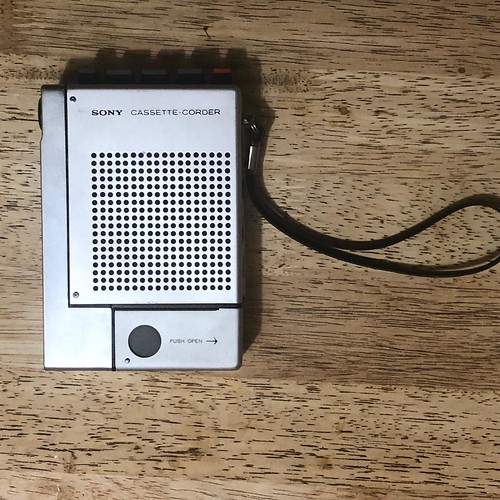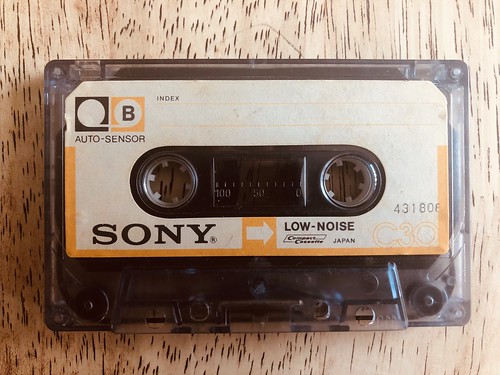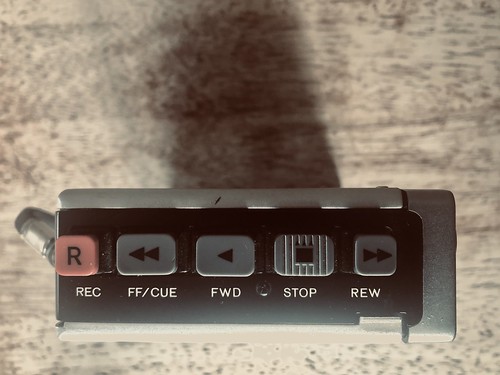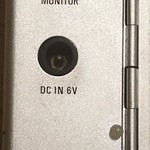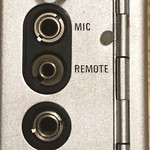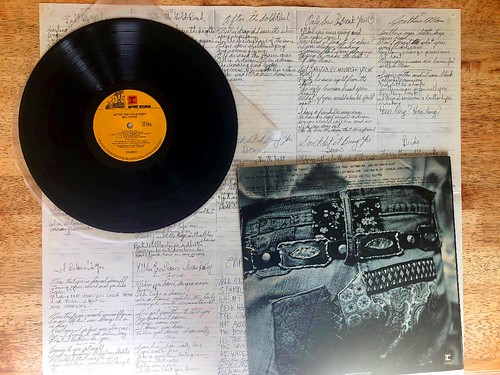❝ A new hacking project, the SONY TC-55 from the '70s
Man was still exploring the Moon; [0],[1] A hot war in Vietnam was still raging; [2] Whitlam had risen to power in Australia and the Australian Tent Embassy appeared; Motown quit Detroit.
The year was 1972.
That same year Japanese electronics company, SONY released the TC—55 Compact Cassette—Corder. [3] A top of the line model for recording voice and audio using the humble audio casette for media.
Compact Cassette
PHILIPS, the Dutch Electronics giant, released the Compact Cassette [4] as an audio recording medium in 1962. One of many tape recoding media at this time, the cassette had multiple advantages of size, recording length and cost. SONY chose this format for its range of audio record and players and as of 2020 the cassette, though harder to source is still in use.
The Plan
The TC—55 is a work of Art, a beautiful combination of steel, leather and electronics. So what do I have in mind? Repair and use as a player for modern Indy bands recordings? Not a chance. Even if I could get the parts, putting these into working order requires levels of skill, parts and understanding beyond me. [5]
A New Home
I'm looking a home for an an audio project I'm working on. Nothing fancy, a low end commodity electronics: A RaspberryPi Zero; [6] RaspberryPi Zero—W [7] with a HiFiBerry—DAC chip [8] found on the Pimoroni Pirate Audio. [9] Rather than trying to squash it all into a Cassette, an Altoids Tin [10] or a 3D printed case.
I've got a better idea.
Peak User Interface
SONY crafted products with both attention to detail and an eye for beauty. Curved surfaces, grouped functionality, technical details hidden, peak User Interface (UI).
If I carefully modify the case innards, add a small computer, some audio electronics and battery system, I might get away with using the existing interface with a modern audio. Re—using the well made old technology as a home for my hacked together audio hardware.
I think it'll work, the UI is good and there's enough space and functionality to use.
I love re-purposing old stuff, rather than fall into the throw-away culture, I want to re-use the best of old technology and re-purpose it with smaller music technology capable. [11]
Emotional Assets
When I handle the TC—55 I get a sense of how things as little as fifty years ago things were built with care and attention to detail. Beautiful, useful with meaning, an emotional asset. A tool that has more value than its function. [6] I may never replace the quality of my Vinyl, but I can repurpose this tool. If it breaks, I can fix it. I can improve the underlying technology, extending the working life well beyond the limits of original purpose.
Seven years into the future, this model morphed into the SONY walkman.
A Burst Of Creativity
"I may never replace the quality of my #vinyl, but I can extend where I hear the music I have."
In researching the TC—55, I came across some radical SONY portable music technology. Take the SRF—80W, yes that's an 80 watt stereo portable "Boom Box". [12] Then there's the PS—F9. [13] I remember seeing this when it come out in 1983. I'd heard about the new music format in 1978. It was called the Compact Disc. A superior music medium. The very next year the D—50 came out. [14]
The Vinyl record and Cassette was replaced with a slim disc of plastic, the Compact Disc. Music changed at this time. It went from analog to digital and the PS-F9 was one last burst of creativity by SONY.
I doubt SONY could reproduce anything as technically challenging as they did in the 70's and 80's. A single burst of creativity before the digital music onslaught.
Coming Soon.
>>> The 48 Hour Hack
Reference
[0] The NASA Apollo Seventeen mission ran from December 7–19, 1972. It was the last manned mission (Cdr. Eugene Cernan, LMP Harrison Schmitt, and CMP Ronald Evans) to the Moon. Apollo Seventeen was also the only lunar mission to carry a Scientist Geologist Harrison "Jack" Schmitt.
[Last Accessed Monday 19th, 2020]
https://en.wikipedia.org/wiki/Apollo_17
[1] The SONY TC—50 CassetteMaster (predecessor to TC—55) was used in the Apollo Space programme by NASA: "This is one fabulous portable "pocket" size cassette recorder from 1968. It is AC bias, DC erase. It has a nice all-metal case (aluminum) and is historical for a special reason... For any interested parties out there. The part number printed on the original housing is SEB33100262-302."
[Last Accessed Saturday 26th, 2020]
https://www.youtube.com/watch?v=AnuhF6JJXOY
[2] Uncle Phil passing out at "Pucka" (Puckapunyal Army Base) in '71 before going off to train at Jungle Warfare Training Centre at Canungra.
[Last Accessed Monday 19th, 2020]
https://en.wikipedia.org/wiki/Puckapunyal
[3] SONY, TC—55 "When launched, the TC-55 was the latest in a line of miniature cassette recorders from Sony."
[Last Accessed Saturday 26th, 2020]
https://walkmancentral.com/products/tc-55
[4] Compact Cassette: Also called Musicassette, MC, Cassette Tape, Audio Cassette, Tape or plain old "cassette".
[Last Accessed Saturday 26th, 2020]
https://en.wikipedia.org/wiki/Cassette_tape
[5] I'm not sure if it would be a better idea to buy some new drive rubbers for around $25 USD or just go ahead and use the player as it is. There is a chance there is nothing really wrong and I know to use this as a player I will have to cut wires, remove stuff. Ultimately I can still find TC—55s for $20 USD plus shipping. I'm still thinking about how to move forward.
[6] RaspberryPi Zero, the cheapest RaspberryPi at around ten Australian dollars.
[Last Accessed Sunday 27th, 2020]
https://raspberrypi.org/products/raspberry-pi-zero
[7] RaspberryPi Zero Wireless (W)
[Last Accessed Sunday 27th, 2020]
https://www.raspberrypi.org/products/raspberry-pi-zero-w/
[8] HiFiBerry DAC, "DAC stands for “digital-to-analogue converter”. It is designed to convert digital audio data from your Raspberry Pi to an analogue output that you can connect to an external amplifier or receiver."
[Last Accessed Sunday 27th, 2020]
https://hifiberry.com/dacs
[9] Pimoroni Pirate Audio, "a range of digital audio boards for Raspberry Pi, with integrated album art display, tactile buttons for playback control, and a choice of audio outputs."
[Last Accessed Sunday 27th, 2020]
https://learn.pimoroni.com/tutorial/sandyj/getting-started-with-pirate-audio
[10] Altiods Tin, "A mint sold in a tin from the United States. The empty tins make a snug home for electronic hacks."
[Last Accessed Sunday 27th, 2020]
https://en.wikipedia.org/wiki/Altoids
https://flickr.com/photos/bootload/50388096266
[11] I fall short of saying, 'a superior system' because this is the peak of portable analog recording and playing of sound.
[12] SRF-80W Part amplifier, part speaker, the SRF, came in two parts, a pocket-sized AM/FM stereo receiver and a large stereo loudspeaker/amplifier unit into which the receiver fitted."
[Last Accessed Monday 19th, 2020]
https://walkmancentral.com/products/srf-80w
[13] PS—F9 "as close as Sony ever got to producing a Walkman for LP records and 45 rpm singles."
[Last Accessed Monday 19th, 2020]
https://walkmancentral.com/products/ps-f9
[14] DM—50 "the first portable compact disc player. Released only shortly after the compact disc system was introduced, it represented a major technical achievement, and was of course “the world’s smallest compact disc player” at launch."
[Last Accessed Monday 19th, 2020]
https://walkmancentral.com/products/d-50
[15] FLAC, "Free Lossless Audio Codec" I will use many formats, however FLAC is by far the best for sound quality.
[Last Accessed Sunday 27th, 2020]
https://en.wikipedia.org/wiki/FLAC
